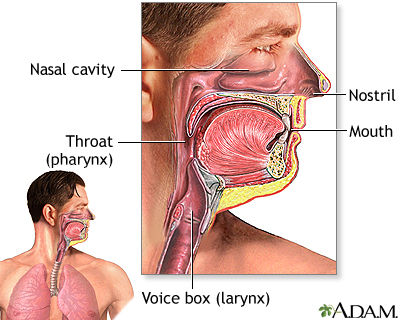Stridor
Breathing sounds - abnormal; Extrathoracic airway obstruction; Wheezing - stridor
Stridor is an abnormal, high-pitched, musical breathing sound. It is caused by a blockage in the throat or voice box (larynx). It is most often heard when taking in a breath.
Images

I Would Like to Learn About:
Considerations
Children are at higher risk of airway blockage because they have narrower airways than adults. In young children, stridor is a sign of airway blockage. It must be treated right away to prevent the airway from becoming completely closed.
The airway can be blocked by an object, swollen tissues of the throat or upper airway, or a spasm of the airway muscles or the vocal cords.
Causes
Common causes of stridor include:
- Airway injury
- Allergic reaction
- Problem breathing and a barking cough (croup)
- Diagnostic tests such as bronchoscopy or laryngoscopy
- Epiglottitis, which is inflammation of the movable cartilage that covers the windpipe
- Inhaling an object such as a peanut or marble (foreign body aspiration)
- Swelling and irritation of the voice box (laryngitis)
- Neck surgery
- Use of a breathing tube for a long time
- Secretions such as phlegm (sputum)
- Smoke inhalation or other inhalation injury
- Swelling of the neck or face
- Swollen tonsils or adenoids (such as with tonsillitis)
- Vocal cord cancer
Home Care
Follow your health care provider's advice to treat the cause of the problem.
When to Contact a Medical Professional
Stridor may be a sign of an emergency. Contact your provider right away if there is unexplained stridor, especially in a child.
What to Expect at Your Office Visit
In an emergency, your provider will check your temperature, pulse, breathing rate, and blood pressure, and may need to do abdominal thrusts to clear the airway.
A breathing tube may be needed if you can't breathe properly.
After you are stable, your provider may ask about your medical history, and perform a physical exam. This includes listening to your lungs.
Parents or caregivers may be asked the following medical history questions:
- Is the abnormal breathing a high-pitched sound?
- Did the breathing problem start suddenly?
- Could the child have put something in their mouth?
- Has the child been ill recently?
- Is the child's neck or face swollen?
- Has the child been coughing or complaining of a sore throat?
- What other symptoms does the child have? (For example, nasal flaring or a bluish color to the skin, lips, or nails)
- Is the child using chest muscles to breathe (intercostal retractions)?
Tests that may be done include:
- Arterial blood gas analysis
- Bronchoscopy
- Chest CT scan
- Laryngoscopy (examination of the voice box)
- Pulse oximetry to measure blood oxygen level
- X-ray of the chest or neck
Related Information
WheezingReferences
Griffiths AG. Chronic or recurrent respiratory symptoms. In: Kliegman RM, St. Geme JW, Blum NJ, Shah SS, Tasker RC, Wilson KM, eds. Nelson Textbook of Pediatrics. 21st ed. Philadelphia, PA: Elsevier; 2020:chap 401.
Rose E. Pediatric upper airway obstruction and infections. In: Walls RM, ed. Rosen's Emergency Medicine: Concepts and Clinical Practice. 10th ed. Philadelphia, PA: Elsevier; 2023:chap 162.
Zalzal HG, Zalzal GH. Stridor in the Infant Patient. Pediatr Clin North Am. 2022;69(2):301-317. PMID: 35337541 pubmed.ncbi.nlm.nih.gov/35337541/.
BACK TO TOPReview Date: 4/1/2024
Reviewed By: Charles I. Schwartz, MD, FAAP, Clinical Assistant Professor of Pediatrics, Perelman School of Medicine at the University of Pennsylvania, General Pediatrician at PennCare for Kids, Phoenixville, PA. Also reviewed by David C. Dugdale, MD, Medical Director, Brenda Conaway, Editorial Director, and the A.D.A.M. Editorial team.

Health Content Provider
06/01/2025
|
A.D.A.M., Inc. is accredited by URAC, for Health Content Provider (www.urac.org). URAC's accreditation program is an independent audit to verify that A.D.A.M. follows rigorous standards of quality and accountability. A.D.A.M. is among the first to achieve this important distinction for online health information and services. Learn more about A.D.A.M.'s editorial policy, editorial process and privacy policy. A.D.A.M. is also a founding member of Hi-Ethics. This site complied with the HONcode standard for trustworthy health information from 1995 to 2022, after which HON (Health On the Net, a not-for-profit organization that promoted transparent and reliable health information online) was discontinued. |
The information provided herein should not be used during any medical emergency or for the diagnosis or treatment of any medical condition. A licensed medical professional should be consulted for diagnosis and treatment of any and all medical conditions. Links to other sites are provided for information only -- they do not constitute endorsements of those other sites. © 1997- 2025 A.D.A.M., a business unit of Ebix, Inc. Any duplication or distribution of the information contained herein is strictly prohibited.
